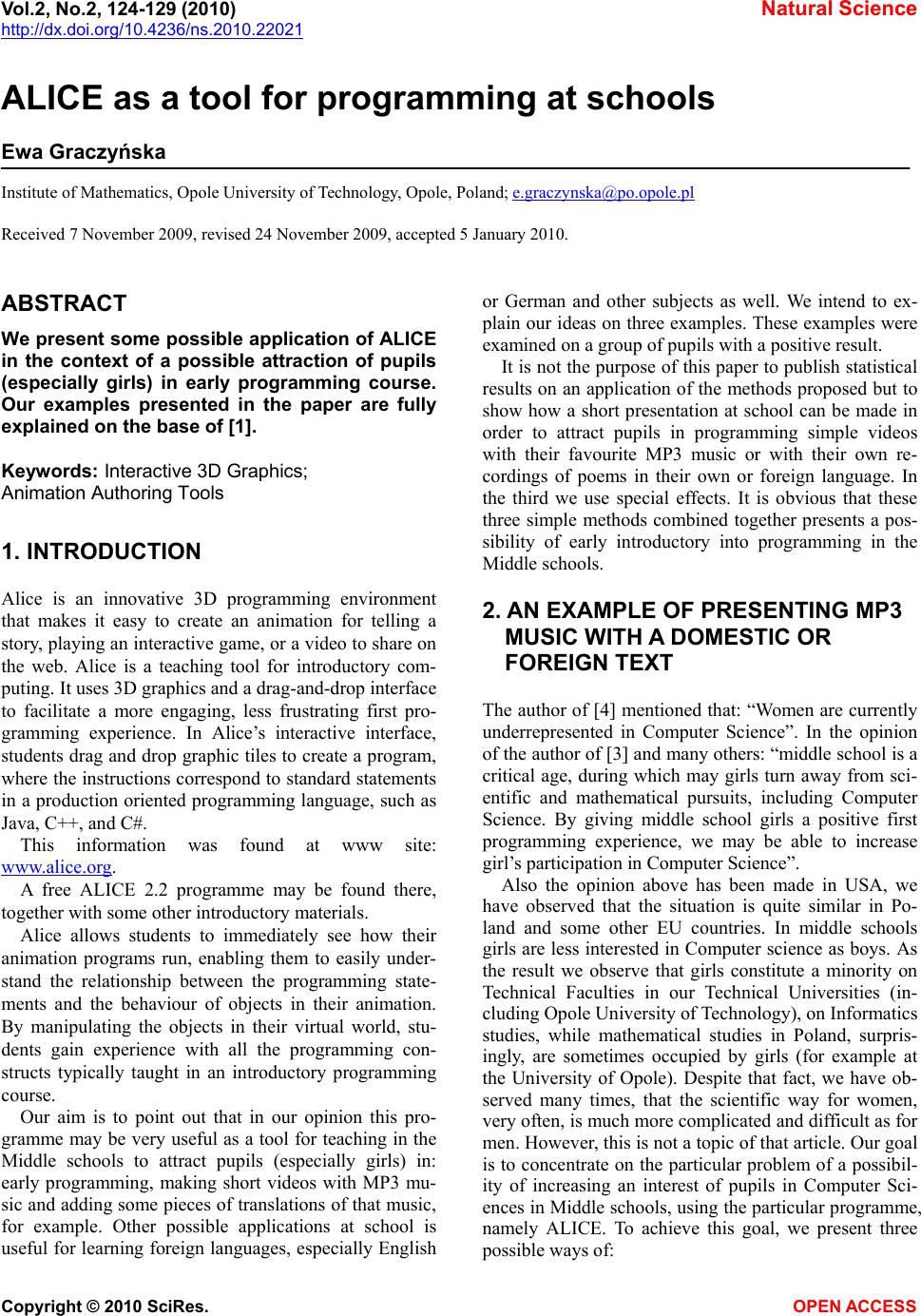
Vol.2, No.2, 124-129 (2010) Natural Science
http://dx.doi.org/10.4236/ns.2010.22021
Copyright © 2010 SciRes. OPEN ACCESS
ALICE as a tool for programming at schools
Ewa Graczyńska
Institute of Mathematics, Opole University of Technology, Opole, Poland; e.graczynska@po.opole.pl
Received 7 November 2009, revised 24 November 2009, accepted 5 January 2010.
ABSTRACT
We present some possible application of ALICE
in the context of a possible attraction of pupils
(especially girls) in early programming course.
Our examples presented in the paper are fully
explained on the base of [1].
Keywords: Interactive 3D Graphics;
Animation Authoring Tools
1. INTRODUCTION
Alice is an innovative 3D programming environment
that makes it easy to create an animation for telling a
story, playing an interactive game, or a video to share on
the web. Alice is a teaching tool for introductory com-
puting. It uses 3D graphics and a drag-and-drop interface
to facilitate a more engaging, less frustrating first pro-
gramming experience. In Alice’s interactive interface,
students drag and drop graphic tiles to create a program,
where the instructions correspond to standard statements
in a production oriented programming language, such as
Java, C++, and C#.
This information was found at www site:
www.alice.org.
A free ALICE 2.2 programme may be found there,
together with some other introductory materials.
Alice allows students to immediately see how their
animation programs run, enabling them to easily under-
stand the relationship between the programming state-
ments and the behaviour of objects in their animation.
By manipulating the objects in their virtual world, stu-
dents gain experience with all the programming con-
structs typically taught in an introductory programming
course.
Our aim is to point out that in our opinion this pro-
gramme may be very useful as a tool for teaching in the
Middle schools to attract pupils (especially girls) in:
early programming, making short videos with MP3 mu-
sic and adding some pieces of translations of that music,
for example. Other possible applications at school is
useful for learning foreign languages, especially English
or German and other subjects as well. We intend to ex-
plain our ideas on three examples. These examples were
examined on a group of pupils with a positive result.
It is not the purpose of this paper to publish statistical
results on an application of the methods proposed but to
show how a short presentation at school can be made in
order to attract pupils in programming simple videos
with their favourite MP3 music or with their own re-
cordings of poems in their own or foreign language. In
the third we use special effects. It is obvious that these
three simple methods combined together presents a pos-
sibility of early introductory into programming in the
Middle schools.
2. AN EXAMPLE OF PRESENTING MP3
MUSIC WITH A DOMESTIC OR
FOREIGN TEXT
The author of [4] mentioned that: “Women are currently
underrepresented in Computer Science”. In the opinion
of the author of [3] and many others: “middle school is a
critical age, during which may girls turn away from sci-
entific and mathematical pursuits, including Computer
Science. By giving middle school girls a positive first
programming experience, we may be able to increase
girl’s participation in Computer Science”.
Also the opinion above has been made in USA, we
have observed that the situation is quite similar in Po-
land and some other EU countries. In middle schools
girls are less interested in Computer science as boys. As
the result we observe that girls constitute a minority on
Technical Faculties in our Technical Universities (in-
cluding Opole University of Technology), on Informatics
studies, while mathematical studies in Poland, surpris-
ingly, are sometimes occupied by girls (for example at
the University of Opole). Despite that fact, we have ob-
served many times, that the scientific way for women,
very often, is much more complicated and difficult as for
men. However, this is not a topic of that article. Our goal
is to concentrate on the particular problem of a possibil-
ity of increasing an interest of pupils in Computer Sci-
ences in Middle schools, using the particular programme,
namely ALICE. To achieve this goal, we present three
possible ways of: